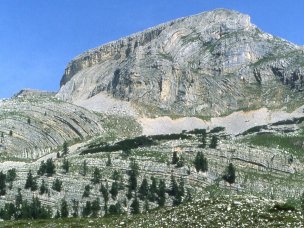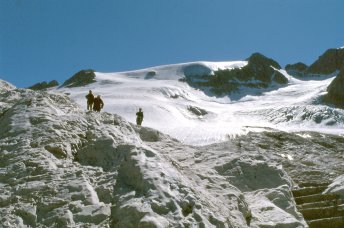|
The
Fanes saga - Short essays
Pills of geology
A
few geological definitions, on the purpose of better understanding
the origin and structure of the Dolomites.
Here
are some types of rock that can be encountered in the Dolomites:
Limestone:
a sedimentary rock of marine origin, composed of calcium carbonate
Dolomite:
a sedimentary rock of marine origin, composed of double carbonate
of calcium and magnesium
Marl:
a crumbly sedimentary rock, composed of compacted clay and calcite
(crystalline calcium carbonate)
Sandstone:
a sedimentary rock, composed of compacted sand
Tuff:
a porous sedimentary rock, composed of compacted volcanic ash
The
age of rocks
Geologists
differentiate rocks according to their age of formation; the main
eras are (from the most recent, top, to the oldest, bottom):
-
Quaternary Era, or Neozoic;
-
Tertiary Era, or Cenozoic;
-
Secondary Era, o Mesozoic;
-
Primary Era, or Archeozoic.
Almost all
Dolomitic rocks belong to the Mesozoic. This,
in its turn, can be divided in periods according to the following
table, again from the most recent on top, down to the oldest at
bottom (somewhat simplified):
The formation of rocks
Most
Dolomitic rocks are of sedimentary organic marine origin, i.e.
originated by slow deposition on the sea bottom of the shells
of sea animals and other organic detritus. In detail, the Dolomitic
rocks deposited when the sea was shallow (lagoons,
coastal platforms). The sea bottom was sinking;
as it got deeper, new layers could deposit. At periods, sedimentations
was interrupted and a thin silt layer deposited, so that the rock
was divided into overlying layers (strata).
In the rock, mineralized but still recognizable shells or skeletons
were sometimes incorporated, the so-called fossils.
Later on, under the pressure of the overlying layers, the deposited
material compacted into solid rock, like that we can see today.
The deposition of Dolomitic rocks started in the Anisian period
and ended at the beginning of Cretaceous. During the Ladinian
period, two volcanoes emerged, east of the Fassa valley, that
erupted the dark rocks like those of the Padon and of mount Pore.
The dolomite deposited during the Norian period represents the
largest part of the classic Dolomitic cliffs and was named Main
Dolomite.
 |
Strata
near the big Fanes Alp. Remark the sub-horizontal
layers in the foreground and the inclined, contorted
and broken ones on the left and in the background.
(Photo: Vanin)
|
|
|
 |
| What
remains of the Marmolada glacier. Notice the rocks
in the foreground, smoothed by ice abrasion. (Photo:
Vanin).
|
|
|
|
The
formation of mountains
The
sedimentary layers of the Dolomites remained for several million
years buried deep under the sea bottom, where they compacted into
hard rock. About 25 million years ago, the push of the African
continent against the European plate started lifting the Earth’s
crust, forming the Alps. Because of this phenomenon, the Dolomites
also were raised up to thousands meters above sea level and exposed
to daylight. The movement caused the strata to incline, to bend,
to break.
Erosion,
karstification and glaciers
As
soon as they start emerging from the sea, rocks are subjected
to erosion, mainly for the action of rain and of snow-melting
waters. This way the network of the river valleys takes shape.
Stones and boulders detach from the cliff walls and form scree
slopes (talus); rivers carry them away, grind
them, round them and sometimes deposit them in the lake basins
or on the sides of the valleys.
A peculiar
phenomenon is karstification, typical of the
rocks soluble into water, like dolomite (a little) and limestone
(much more). Instead of flowing on the surface, water penetrates
underground through the joints that have opened during the process
of mountain raising, and enlarges them wider and wider, forming
caves. On the surface, dry stonefields remain, marked by deep
grooves (karren, lapiaz) and funnel-shaped hollows
(dolines). A stream may suddenly disappear underground
(sinkhole). Water reappears at the base of the
mountains, forming karstic springs.
When
temperature is low enough and humidity high enough, on the mountains
we have the formation of glaciers.
Ice cumulates in high-altitude basins, moves downwards very slowly,
forming iceflows, sometimes carrying detritus that is relinquished
where the ice melts (moraines). This phenomenon
was specially intensive in the so-called Ice Ages
of the Quaternary Era, separated by warmer periods called interglacial
stages.
|

